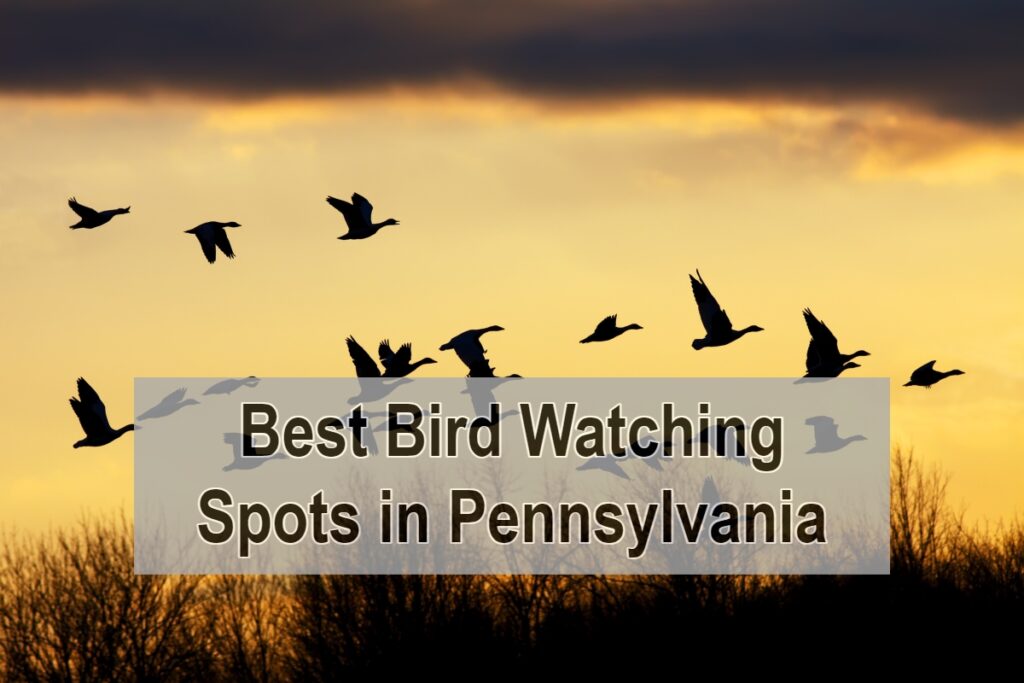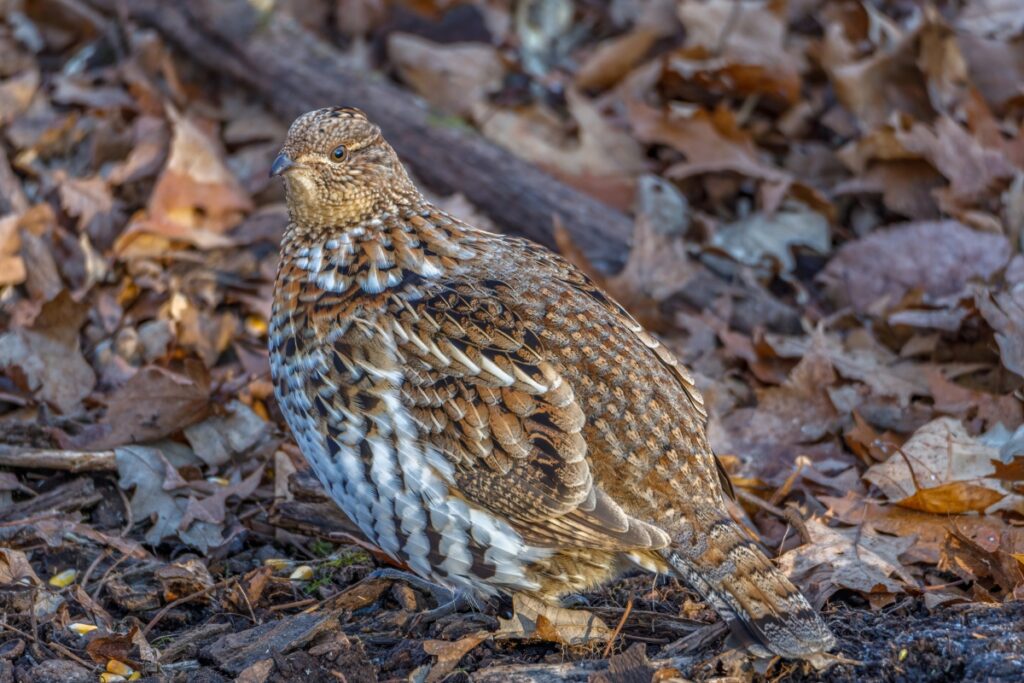As an Amazon Associate, we earn from qualifying purchases with no additional costs for you.
Pennsylvania has quite a sizeable human population, but still has enough bird habitats, with 436 species recorded in the state. Knowing which the best spots are for birds is not always easy, so I compiled this list of the best places for bird watching.
The best bird watching spots in Pennsylvania are those with various habitats, such as John Heinze National Wildlife Refuge, Bald Eagle State Park, and Peace Valley Park. Presque Isle State Park on the shore of Lake Erie is also an excellent birding spot.
A table giving the most exciting birds you can see at each of my top 12 birding spots in Pennsylvania:
| PARK | INTERESTING BIRDS YOU CAN SEE |
|---|---|
| Pymatuning State Park | Sandhill Crane and Bobolink |
| John Heinz National Wildlife Refuge at Tinicum | Osprey and Black-crowned Night Heron |
| Bald Eagle State Park | Bald Eagle and Ruffed Grouse |
| Loyalsock State Forest | Blackburnian Warbler and Northern Saw-whet Owl |
| Middle Creek Wildlife Management Area | Snow Goose and Grasshopper Sparrow |
| Hawk Mountain Sanctuary | Northern Goshawk and Golden Eagle |
| Peace Valley Park | Red-throated Loon and Broad-winged Hawk |
| Yellow Creek State Park | Red-shouldered Hawk and Blackburnian Warbler |
| Lake Ontelaunee | Horned Grebe and White-winged Crossbill |
| Presque Isle State Park | Piping Plover and Purple Sandpiper |
| Codorus State Park | Fish Crow and Lesser Scaup |
| Fort Washington State Park | Northern Saw-whet Owl and Sharp-shinned Hawk |
Read on below to learn more about my best spots for bird watching in Pennsylvania and which birds to look out for in each of these spots.
TIP: If you want to check out the best pair of binoculars for bird watching, we recommend a pair of waterproof and fog-proof 8 x 42 binoculars like the Celestron – Outland X 8×42 Binoculars (Amazon link).
Best Places to Bird Watch in Pennsylvania
Pennsylvania has many bird habitats, so there are some terrific sites for birders to visit.
1. Pymatuning State Park
This park is situated in the northwest of the state. It has woodlands, lakes, and ponds, which attract many bird species. In fact, 258 species of birds have been recorded in the park according to the checklist for the area.
The park includes the large reservoir, the 17,088-acre Pymatuning Reservoir. This is a great place to see waterfowl, and it is recommended that you also look at Miller Ponds and the spillway close to Hartstown Road.
Waterfowl species in this state park include Ruddy Duck, Long-tailed Duck, Bufflehead, Canvasback, Red-breasted Merganser, Hooded Merganser, Surf Scoter, Blue-winged Teal, Redhead, and Gadwall. Geese are also present here, including Cackling Geese and Snow Geese.
There have also been Sandhill Cranes, and Bobolinks observed in the park and Bald Eagles nest in the area. Other birds in the forested patches include American Redstarts, Blue-winged Warblers, and Scarlet Tanagers.
TIP: Check out my recommended products if you are looking for the best and trusted equipment for birdwatching in the wild or on your backyard (Amazon link):
- Celestron Outland X 8×42 Binoculars
- Celestron Ultima 80 Angled Spotting Scope
- National Audubon Society Birds of North America Book
- Design Free-standing Bird Bath
- Smart Bird Feeder with Camera
- Cedar Bird House for Outside
2. John Heinz National Wildlife Refuge at Tinicum
John Heinz National Wildlife Refuge at Tinicum has about 10 miles of trails and a visitors center where you can find more information about the refuge, including a bird species checklist.
This refuge has a freshwater tidal marsh and reservoir, and wooded and scrub areas are present. These different habitats mean that various birds can be found here, including large numbers of shorebirds in summer.
You can find nesting Bald Eagles, Ospreys, and Black-crowned Night Herons here. Both Acadian and Willow Flycatchers have been recorded in the refuge. Swamp Sparrows and Marsh Wrens can be found in vegetation in wetland areas.
3. Bald Eagle State Park
There is a 1,700-acre lake in the park, and it does have Bald Eagles year-round. You can walk on several trails and roads where you can drive and look for birds.
Spring migration is an excellent time to see birds in the area. Bird species you can find in the wooded regions include these species:
- Black-and-white Warbler,
- Wood Thrush,
- Hooded Warbler,
- American Redstart,
- Chestnut-sided Warbler,
- Ovenbird,
- Worm-eating Warbler.
Besides thrushes and warblers, you can often spot Baltimore, Scarlet Tanagers, and Orchard Orioles. You can also look for species like the Red-necked Grebe, Red-breasted Merganser, Tundra Swan, and Long-tailed Duck. Broad-winged Hawks and Ruffed Grouse also occur and breed in the park.
4. Loyalsock State Forest
The hardwood trees found in this state forest include pine and hemlock. There are many birds found in these forests, including woodpeckers and warblers.
You can find the following bird species in the forest at Loyalsock: Ruffed Grouse, Magnolia Warbler, Blackburnian Warbler, Northern Saw-whet Owl, Golden-crowned Kinglet, and Black-throated Green Warbler.
TOP TIP: The binoculars you use for bird watching make a significant difference in the experience. Bird watchers tend to use specific binoculars that are ideally suited for the activity, and determining the best type for you is critical. Take a look at these articles that outline 10×50 and 10×42 binoculars to help you understand which type is best for you.
5. Middle Creek Wildlife Management Area
This wildlife area is just west of Reading, Pennsylvania, and is known for its shallow ponds and high species richness.
At least 270 species of birds have been observed in this area. Bald Eagles nest here, as do Ospreys. This is also a great spot to see thousands of Snow Geese.
There is an autoroute you can drive along to see birds. This route is open from March to September yearly and loops around Middle Creek Reservoir.
You can see various birds, such as Grasshopper Sparrows, Swamp Sparrows, Orchard Orioles, Baltimore Orioles, Northern Parulas, and Yellow-throated Vireos. It is an excellent spot to see Wild Turkeys nest in the refuge.
6. Hawk Mountain Sanctuary
Hawk Mountain Sanctuary is a good spot on an Appalachian Mountain ridge to watch migrating raptors. Hawk Watching is commonly done here.
Birds you can spot here during hawk migration from September to November include species such as Golden Eagle, Bald Eagle, Northern Harrier, Broad-winged Hawk, Red-tailed Hawk, and Sharp-shinned Hawk. Rough-legged Hawks can also be seen, but most often near the end of November and into December.
7. Peace Valley Park
This park is 1,500 acres in size and is rich in birdlife. A reservoir (Lake Galena), open fields, pine woodlands, and hardwood forests provide ample habitat for bird species. This is designated by the Audubon Society as an important bird area, with 295 species recorded.
You can see birds like the Acadian Flycatcher, Golden-crowned Kinglet, Tufted Titmouse, Cape May Warbler, Magnolia Warbler, Chestnut-sided Warbler, Blue-headed Vireo, Palm Warbler, and Northern Parula.
You can also find waterfowl on the lake. Such species to watch for here include the following: Redhead, Ring-necked Duck, Blue-winged Teal, Common Loon, Red-throated Loon, and White-winged Scoter. Keep an eye out for Bonaparte’s Gulls and Tundra Swans.
Broad-winged Hawks and Peregrine Falcons have been observed in the park. You can use a complete bird species checklist for the area when planning your visit.
TIP: Knowing how to spot the birds in your yard is key to enjoying visits from your winged friends as much as possible! The best sources are trusted books, I recommend using the following (Amazon links):
– National Geographic Field Guide to the Birds of North America
– National Audubon Society Birds of North America
8. Yellow Creek State Park
This park is 2,981 acres in size, located almost an hour’s drive east of Pittsburgh. There is a lake and various trails you can walk on. The park attracts waterfowl in winter and songbirds during spring migration. Shorebirds can be seen on the edge of the lake.
A popular trail is the Waterfowl Observatory Trail. The birds you can find include waterfowl such as Horned Grebes, Pied-billed Grebes, and Common Loons.
Birds known to breed in the park include Red-shouldered Hawks, Broad-winged Hawks, Pileated Woodpeckers, and several passerine species. Orioles and Indigo Buntings can be seen in the park.
Bird species recorded at Yellow Creek State Park include songbirds, such as the Rose-breasted Grosbeak, Louisiana Waterthrush, Hooded Warbler, Magnolia Warbler, Brown Creeper, Blue-winged Warbler, Black-throated Green Warbler, Scarlet Tanager, and Chestnut-sided Warbler.
9. Lake Ontelaunee
Lake Ontelaunee is a 1,082-acre reservoir, a good spot for bird watchers looking for waterfowl. You can see waterfowl species like Gadwall, Common Loon, American Wigeon, Northern Pintail, Horned Grebe, Red-breasted Merganser, and Pied-billed Grebe.
The loons are most abundant between November and April. Scoter species are often present if the weather has been stormy; such species include White-winged Scoter, Black Scoter, and Surf Scoter.
At times, long-tailed Ducks and Pacific Loons have also been observed on the lake. Snow Geese arrive in flocks during winter. Herring Gulls and Ring-billed Gulls are commonly seen here, and Bald Eagles breed in the area.
Osprey has been recorded fishing in the lake. You can also see birds by walking along some of the trails. You can find marsh species like the Sora, Virginia Rail, Marsh Wren, and Common Moorhen.
There is a patch of spruce trees at the backend of the lake past Maidencreek Road, where you can sometimes find White-winged Crossbills and Red-breasted Nuthatches in winter.
TOP TIP: Understanding the best practices for birding according to season, and what birds may be likely to eat in certain seasons, are critical aspects of bird watching that can help improve your ability to find the birds you are after.
10. Presque Isle State Park
Presque Isle State Park is an excellent bird watching site because it is situated along the shores of Lake Erie. This means that it is a terrific spot for spring migrants. Three hundred twenty-six species have been recorded here, making this a place any birder should visit.
The marshy areas attract bird species like Virginia Rail, King Rail, and Sora. Shorebirds can be seen along the beach. You can find species such as Purple Sandpiper, Least Sandpiper, Semipalmated Sandpiper, Lesser Yellowlegs, and Piping Plover. American Golden Plover has also been recorded in the park.
Warblers recorded in the park include the following species: Bay-breasted Warbler, Black-throated Green Warbler, Blackpoll Warbler, Tennessee Warbler, and Wilson’s Warbler. White-eyed Vireos and Philadelphia Vireos have also been recorded here.
Waterfowl include Red-breasted Mergansers, Hooded Mergansers, Common Mergansers, Surf Scoters, Long-tailed Ducks, and American Wigeons.
You can also see Ring-billed Gulls and Herring Gulls. The park also includes Osprey, Cooper’s Hawk, Red-shouldered Hawk, American Kestrel, and Bald Eagle.
11. Codorus State Park
This park is 3,500 acres and contains Lake Marburg, which attracts waterfowl and shorebirds. At least 240 bird species have been noted in the area.
The Audubon Society designates Codorus State Park as an important bird area, and it has species like Lesser Scaup, Fish Crow, Bufflehead, Belted Kingfisher, Common Merganser, and Osprey.
There are also passerines such as Great Crested Flycatchers, Baltimore Orioles, Ruby-crowned Kinglets, Wood Thrushes, House Wrens, White-eyed Vireos, and Blue-headed Vireos.
Warbler species are also found here. You can find such species as Blackpoll Warbler, Prairie Warbler, Yellow Warbler, Yellow-rumped Warbler, Pine Warbler, and Palm Warbler.
13. Fort Washington State Park
At least 192 species of birds have been recorded in Fort Washington State Park. The park is 493 acres and is known for its oak trees. This spot is excellent for migrant songbirds because these oak trees provide a rich food source.
You can find some exciting raptors here, such as the Sharp-shinned Hawks, Red-shouldered Hawks, and Cooper’s Hawks. There is an observation deck at Militia Hill helpful in winter when the most raptors can be seen. Northern Saw-whet Owls and Great Horned Owls have also been recorded here.
Best Time to Bird Watch in Pennsylvania
Pennsylvania has such a rich birdlife that you can always see birds at any time of the year. There are, however, some species that may be more numerous at certain times.
| TYPES OF BIRDS | SEASON |
|---|---|
| Waterfowl | Winter |
| Shorebirds | July to September |
The Pennsylvania State Bird
The Pennsylvania state bird is the Ruffed Grouse, Bonasa umbellus. This brown bird looks similar to a chicken and is in the same Order: Galliformes. The Ruffed Grouse is found in forests and woodlands.
The grouse prefer walking and running along the ground, and they can be tricky to spot as their coloration makes them well hidden.
Male grouse drum in spring to attract a mate. The birds build a nest on the ground, and the chicks are precocial, meaning they can run around as soon as they are born.
Bird Watching Laws in Pennsylvania
It is unlawful to have or harm any bird protected in the state. You also may not help anyone trying to catch wild birds.
My Favourite Equipment for Bird Watching
Bird watching is one of the least expensive hobbies out there, but you still need some equipment to get the most out of it.
The essential equipment to start bird watching is a pair of binoculars. My preference is 8 X 42 binoculars. The number 8 is how much the magnification is, while 42 is the field of view in millimeters of the lenses.
A pair of waterproof and fog-proof 8 x 42 binoculars like the Celestron – Outland X 8×42 Binoculars on Amazon is an excellent choice for both beginners and experts.
In time, you can choose more expensive models and also opt to buy a spotting scope like the Celestron Ultima 80 on Amazon.
These are a lot more expensive compared with binoculars though, so if you are only a beginner, start with binoculars first. A spotting scope is only helpful for birds far away, such as out on a pond or seashore.
There are a few rules or guidelines you should abide by as an ethical birder. These are listed below.
- Do not enter private lands without prior permission from landowners.
- Follow all the rules in refuges and reserves, including cleaning up any garbage from your campsite.
- Do not disturb birds on nests.
- Do not use apps and play songs to call up birds when they are hungry, tired, and breeding during spring and summer.
Conclusion
Pennsylvania has many birds to be found in the open fields, forests, and lakes. While the best birding is in central areas of the state, there are also areas along Lake Erie that provide excellent birding opportunities during spring migration. Pennsylvania is definitely a state to add to your bird watching list.
TIP: If you want to check out the best pair of binoculars for bird watching, we recommend a pair of waterproof and fog-proof 8 x 42 binoculars like the Celestron – Outland X 8×42 Binoculars (Amazon link).


